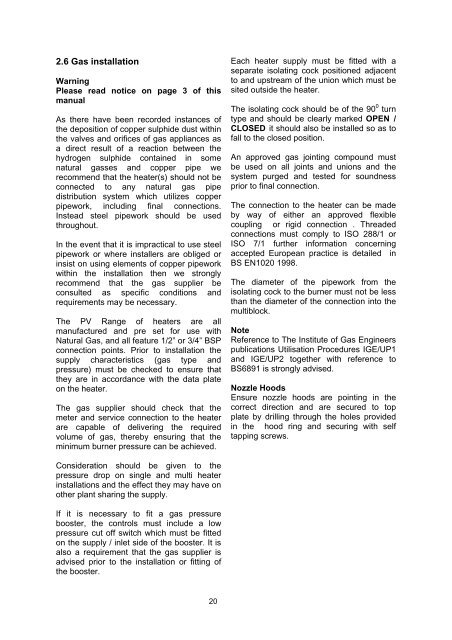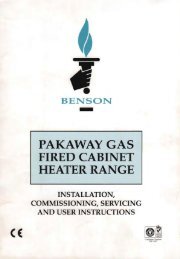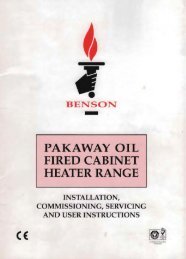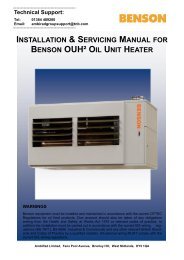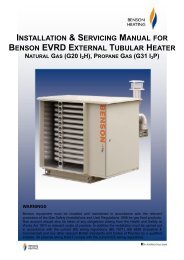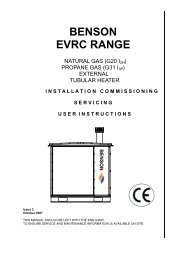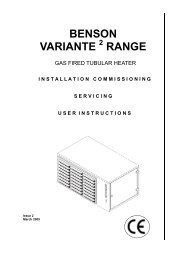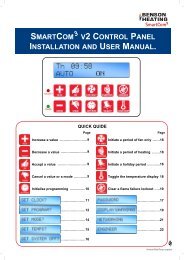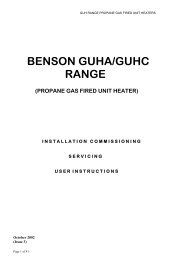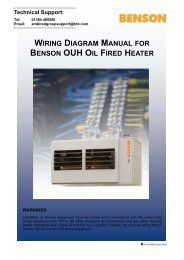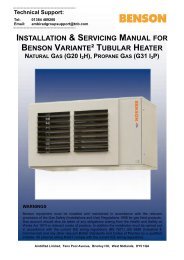INSTALLATION & SERVICING MANUAL BENSON PV TUBULAR CABINET HEATER
DONOTUSE Benson PV Range Mar2011 issue11 - AmbiRad
DONOTUSE Benson PV Range Mar2011 issue11 - AmbiRad
- No tags were found...
You also want an ePaper? Increase the reach of your titles
YUMPU automatically turns print PDFs into web optimized ePapers that Google loves.
2.6 Gas installation<br />
Warning<br />
Please read notice on page 3 of this<br />
manual<br />
As there have been recorded instances of<br />
the deposition of copper sulphide dust within<br />
the valves and orifices of gas appliances as<br />
a direct result of a reaction between the<br />
hydrogen sulphide contained in some<br />
natural gasses and copper pipe we<br />
recommend that the heater(s) should not be<br />
connected to any natural gas pipe<br />
distribution system which utilizes copper<br />
pipework, including final connections.<br />
Instead steel pipework should be used<br />
throughout.<br />
In the event that it is impractical to use steel<br />
pipework or where installers are obliged or<br />
insist on using elements of copper pipework<br />
within the installation then we strongly<br />
recommend that the gas supplier be<br />
consulted as specific conditions and<br />
requirements may be necessary.<br />
The <strong>PV</strong> Range of heaters are all<br />
manufactured and pre set for use with<br />
Natural Gas, and all feature 1/2” or 3/4” BSP<br />
connection points. Prior to installation the<br />
supply characteristics (gas type and<br />
pressure) must be checked to ensure that<br />
they are in accordance with the data plate<br />
on the heater.<br />
The gas supplier should check that the<br />
meter and service connection to the heater<br />
are capable of delivering the required<br />
volume of gas, thereby ensuring that the<br />
minimum burner pressure can be achieved.<br />
Each heater supply must be fitted with a<br />
separate isolating cock positioned adjacent<br />
to and upstream of the union which must be<br />
sited outside the heater.<br />
The isolating cock should be of the 90 0 turn<br />
type and should be clearly marked OPEN /<br />
CLOSED it should also be installed so as to<br />
fall to the closed position.<br />
An approved gas jointing compound must<br />
be used on all joints and unions and the<br />
system purged and tested for soundness<br />
prior to final connection.<br />
The connection to the heater can be made<br />
by way of either an approved flexible<br />
coupling or rigid connection . Threaded<br />
connections must comply to ISO 288/1 or<br />
ISO 7/1 further information concerning<br />
accepted European practice is detailed in<br />
BS EN1020 1998.<br />
The diameter of the pipework from the<br />
isolating cock to the burner must not be less<br />
than the diameter of the connection into the<br />
multiblock.<br />
Note<br />
Reference to The Institute of Gas Engineers<br />
publications Utilisation Procedures IGE/UP1<br />
and IGE/UP2 together with reference to<br />
BS6891 is strongly advised.<br />
Nozzle Hoods<br />
Ensure nozzle hoods are pointing in the<br />
correct direction and are secured to top<br />
plate by drilling through the holes provided<br />
in the hood ring and securing with self<br />
tapping screws.<br />
Consideration should be given to the<br />
pressure drop on single and multi heater<br />
installations and the effect they may have on<br />
other plant sharing the supply.<br />
If it is necessary to fit a gas pressure<br />
booster, the controls must include a low<br />
pressure cut off switch which must be fitted<br />
on the supply / inlet side of the booster. It is<br />
also a requirement that the gas supplier is<br />
advised prior to the installation or fitting of<br />
the booster.<br />
20


